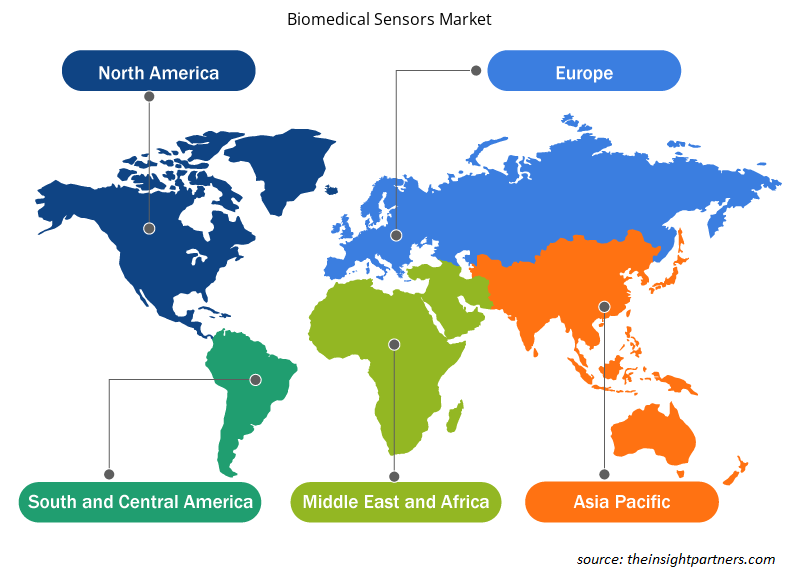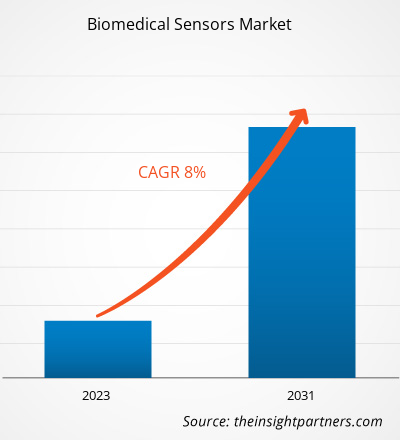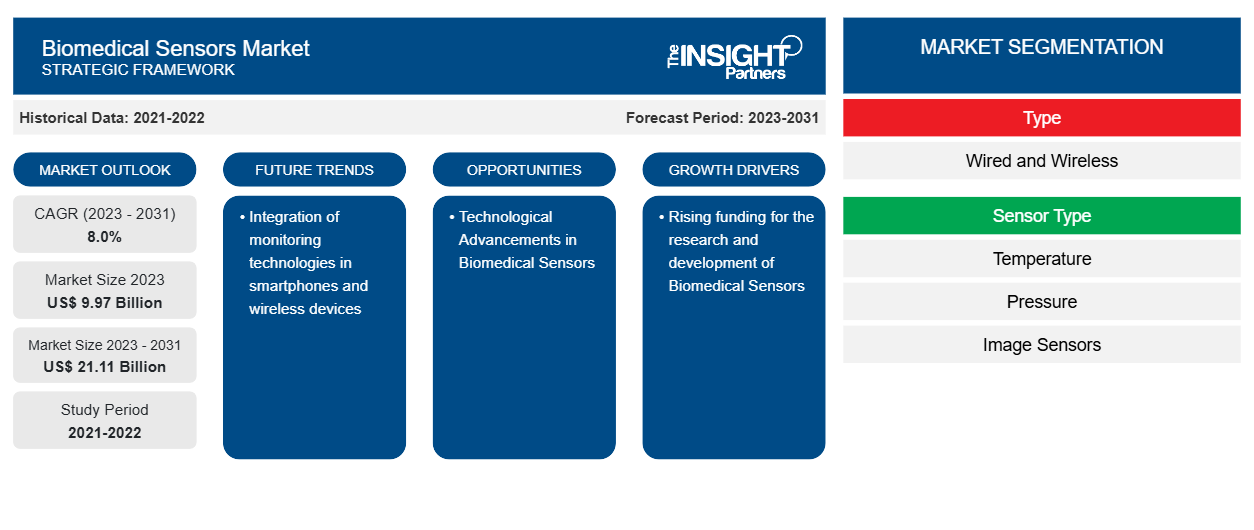생물의학 센서 시장 규모는 2023년 99억 7천만 달러에서 2031년 211억 1천만 달러로 성장할 것으로 추산되며, 시장은 2023~2031년 동안 8.0%의 CAGR을 기록할 것으로 추산됩니다. 스마트폰과 무선 기기에 모니터링 기술을 통합하는 것은 생물의학 센서 시장의 중요한 추세입니다.
생물의학 센서 시장 분석
많은 민간 및 정부 기관이 생물의학 연구를 지원하기 위한 기금을 모금하고 있습니다. 기금은 생물의학 및 공학 분야의 교수진 간 협력 연구를 촉진하는 것을 목표로 하며, 생물의학 장치, 센서 및 시스템 개발에 중점을 둡니다. 2023년 4월, National Institute for Health Research(NiHR i4i Connect)에서 186.7달러 상당의 보조금으로 자금을 지원한 SmartCare: HbA1c Self-Monitoring Technology Research Project가 다양한 혈액 바이오마커에 초점을 맞춘 당뇨병 진단 도구를 실험적으로 검증하는 주요 목표로 시작되었습니다. 과학기술대학 생물의학 공학 연구 센터의 Iasonas Triantis 박사가 이 연구의 수석 연구자(PI)로 임명되었습니다. 마찬가지로 2024년 2월, Novo Nordisk Foundation은 Copenhagen Center for Biomedical Quantum Sensing을 설립하기 위해 2,137만 달러의 보조금을 후하게 지원했습니다. 이 이니셔티브를 통해 생물의학 및 건강 과학 분야는 양자 감지 기술의 출현으로 큰 변화를 겪게 될 것입니다. 이 최첨단 기술은 전례 없는 정밀도로 질병 진단 및 예방에 혁명을 일으킬 것을 약속합니다. 이 국제 연구 협업을 통해 과학자들은 질병의 조기 감지에 사용할 수 있는 새로운 양자 감지 원리와 기술을 개발하고자 합니다.
생물의학 센서 시장 개요
생물의학 센서 시장의 성장은 IoT 기반 의료 기기의 채택 증가, 재택 의료에 대한 수요 급증, 노령 인구 급증, 의료 기기 산업의 기술 발전, 전 세계적으로 증가하는 의료 지출과 같은 요인에 기인합니다. 생물의학 센서 시장은 북미, 유럽, 아시아 태평양, 중동 및 아프리카, 남미 및 중미로 구분됩니다. 북미는 시장에서 가장 큰 점유율을 차지하고 있으며 아시아 태평양은 2023~2031년 동안 가장 빠른 CAGR을 기록할 것으로 예상됩니다. 미국은 생물의학 센서 시장에서 가장 큰 점유율을 차지할 것으로 추정됩니다. 미국의 시장 성장은 주요 생물의학 센서 공급업체가 주요 제조 기반을 확립하기 위해 기울인 노력, 인구 중 급성 및 만성 질환의 증가, 이 나라의 의료 부문의 기술 발전에 기인합니다.
귀하의 요구 사항에 맞게 이 보고서를 사용자 정의하세요
이 보고서의 일부 또는 국가 수준 분석, Excel 데이터 팩을 포함하여 모든 보고서에 대한 사용자 정의를 무료로 받을 수 있으며 신생 기업 및 대학을 위한 훌륭한 혜택과 할인 혜택을 이용할 수 있습니다.
-
이 보고서의 주요 시장 동향을 알아보세요.이 무료 샘플에는 시장 동향부터 추정 및 예측까지 다양한 데이터 분석이 포함됩니다.
생물의학 센서 시장 동인 및 기회
생활 습관병 증가로 시장 호조
스트레스, 비만, 앉아서 지내는 생활 방식, 영양실조, 담배와 알코올 소비와 같은 다양한 요인이 심혈관 질환(CVD)을 포함한 생활 방식 기반 질병의 유병률 증가에 기여합니다. 미국 심장 협회의 "심장 질환 및 뇌졸중 통계-2023" 보고서에 따르면, 관상 동맥 심장 질환은 2021년에 가장 흔한 심장 질환이었으며, 그해에 375,476명의 목숨을 앗아갔습니다. 20세 이상 성인의 약 5%가 관상 동맥 질환 (CAD)을 앓고 있는 것으로 추정됩니다. 따라서 생활 방식 질환의 발병률이 증가함에 따라 정기적인 건강 모니터링에 사용할 수 있는 생물의학 센서에 대한 필요성이 증가하고 있습니다. 최근 도입된 최첨단 CVD 바이오센서와 모니터링 바이오일렉트로닉스는 착용형이든 이식형이든 심장 마커를 지속적으로 측정할 수 있게 했습니다.
미래 시장을 강화할 생물의학 센서의 기술적 발전
마이크로 기술과 나노 기술을 통합한 생물의학 센서의 기술적 발전 으로 인해 모든 개인의 유전적 구성에 적응할 수 있는 소형, 견고하고, 혁신적이며, 비용 효율적인 센서가 도입되고 있습니다. 이러한 센서는 예측할 수 없는 판독값을 기록할 때 경고를 트리거하고, 혈액에서 독성 물질의 존재 여부를 검사하고, 약물을 순환계로 직접 전달하도록 설정되어 있습니다. 이러한 고급 센서의 개발 및 규제 승인에 대한 투자를 늘리면 향후 몇 년 동안 생물의학 센서 시장이 활성화될 가능성이 높습니다. 또한 나노 기술 분야에서 생물의학 센서의 새로운 응용 분야와 지속적인 혁신으로 인해 고급 비침습적 센서 기반 의료 시술이 개발되고 있습니다. 2020년 2월, Missouri S&T의 연구원들은 스마트폰에 연결할 수 있는 일회용 유연한 붕대에 인쇄된 산소 감지 패치를 설계했습니다. 이 스마트 붕대는 압박성 궤양과 같은 상태를 조기에 감지하기 위한 원격 모니터링을 허용하여 즉각적인 치료 또는 개입을 용이하게 할 수 있습니다.
생물의학 센서 시장 보고서 세분화 분석
생물의학 센서 시장 분석에 기여한 주요 세그먼트는 유형, 센서 유형, 제품 및 응용 분야입니다.
- 유형에 따라 생물의학 센서 시장은 유선과 무선으로 나뉩니다. 무선 세그먼트는 2023년에 더 큰 시장 점유율을 차지했습니다.
- 센서 유형별로 시장은 온도, 압력, 이미지 센서, 생화학, 관성 센서, 모션 센서, 심전도 및 기타 센서 유형으로 세분화됩니다. 온도 세그먼트는 2023년에 시장에서 가장 큰 점유율을 차지했습니다.
- 제품 측면에서 시장은 침습형 센서와 비침습형 센서로 나뉩니다. 비침습형 센서 세그먼트는 2023년에 시장에서 더 큰 점유율을 차지했습니다.
- 응용 프로그램을 기준으로 시장은 의료 진단, 임상 치료, 영상 및 개인 건강 관리로 세분화됩니다. 의료 진단 부문은 2023년에 시장에서 가장 큰 점유율을 차지했습니다.
지리적 지역별 생물의학 센서 시장 점유율 분석
생물의학 센서 시장 보고서의 지리적 범위는 주로 북미, 아시아 태평양, 유럽, 중동 및 아프리카, 남미 및 중미의 5개 지역으로 나뉩니다. 북미는 글로벌 생물의학 센서 시장을 지배합니다. 세계보건기구(WHO)에 따르면 매년 약 3천만 명이 뇌졸중을 앓고 있습니다. 미국 심장협회는 2035년까지 미국에서 1억 3천만 명 이상이 심혈관 질환(CVD)을 앓을 것으로 추정한다고 밝혔습니다. 따라서 CVD의 유병률이 증가하는 것은 글로벌 시장에서 북미가 우세하기 때문입니다.
생물의학 센서 시장 지역 통찰력
Insight Partners의 분석가들은 예측 기간 동안 바이오메디컬 센서 시장에 영향을 미치는 지역적 추세와 요인을 철저히 설명했습니다. 이 섹션에서는 북미, 유럽, 아시아 태평양, 중동 및 아프리카, 남미 및 중미의 바이오메디컬 센서 시장 세그먼트와 지리에 대해서도 설명합니다.

- 생물의학 센서 시장을 위한 지역별 데이터 얻기
생물의학 센서 시장 보고서 범위
| 보고서 속성 | 세부 |
|---|---|
| 2023년 시장 규모 | 99억 7천만 달러 |
| 2031년까지 시장 규모 | 211억 1천만 달러 |
| 글로벌 CAGR (2023-2031) | 8.0% |
| 역사적 데이터 | 2021-2022 |
| 예측 기간 | 2023-2031 |
| 다루는 세그먼트 |
유형별로
|
| 포함된 지역 및 국가 |
북아메리카
|
| 시장 선도 기업 및 주요 회사 프로필 |
|
생물의학 센서 시장 참여자 밀도: 비즈니스 역학에 미치는 영향 이해
생물의학 센서 시장 시장은 소비자 선호도의 변화, 기술 발전, 제품의 이점에 대한 인식 증가와 같은 요인으로 인해 최종 사용자 수요가 증가함에 따라 빠르게 성장하고 있습니다. 수요가 증가함에 따라 기업은 제품을 확장하고, 소비자의 요구를 충족하기 위해 혁신하고, 새로운 트렌드를 활용하여 시장 성장을 더욱 촉진하고 있습니다.
시장 참여자 밀도는 특정 시장이나 산업 내에서 운영되는 회사나 기업의 분포를 말합니다. 주어진 시장 공간에 얼마나 많은 경쟁자(시장 참여자)가 존재하는지 그 규모나 전체 시장 가치에 비해 나타냅니다.
생체의학 센서 시장에서 운영되는 주요 회사는 다음과 같습니다.
- 아날로그 디바이스 주식회사
- GE 헬스케어
- ST마이크로일렉트로닉스
- 허니웰 인터내셔널
- 메드트로닉
- NXP 반도체 NV
면책 조항 : 위에 나열된 회사는 어떤 특별한 순서에 따라 순위가 매겨지지 않았습니다.

- 생물의학 센서 시장 주요 업체 개요 알아보기
생물의학 센서 시장 뉴스 및 최근 개발
생물의학 센서 시장은 1차 및 2차 연구 이후의 정성적, 정량적 데이터를 수집하여 평가합니다. 여기에는 중요한 기업 간행물, 협회 데이터 및 데이터베이스가 포함됩니다. 생물의학 센서 시장의 몇 가지 주요 개발 사항은 다음과 같습니다.
- Abbott은 당뇨병 환자를 위한 스마트 인슐린 관리 시스템 개발에 전문성을 갖춘 회사인 Bigfoot Biomedical을 인수했습니다. Bigfoot Biomedical이 개발한 Bigfoot Unity 스마트 인슐린 관리 시스템은 연결된 인슐린 펜 캡을 활용하며, 통합 지속적 포도당 모니터링(iCGM) 데이터와 의료 서비스 제공자의 지시에 따라 작동합니다. (출처: Abbott, 보도자료, 2023)
- Onera Health는 첫 번째 Onera Biomedical Lab-on-Chip을 출시했습니다. 이 바이오메디컬 센서 시스템 온 칩은 여러 생체 신호를 수집하고 처리하도록 설계되었으며, 다양한 웨어러블 건강 기기와 애플리케이션에 적합합니다. 의료, 웰빙 및 피트니스 산업의 혁신을 위한 많은 솔루션과 기회를 제공합니다. (출처: Onera Technologies BV, 보도자료, 2022)
생물의학 센서 시장 보고서 범위 및 제공물
"생체 의료 센서 시장 규모 및 예측(2021-2031)" 보고서는 아래 영역을 포괄하는 시장에 대한 자세한 분석을 제공합니다.
- 범위에 포함된 모든 주요 시장 세그먼트에 대한 글로벌, 지역 및 국가 수준의 생물의학 센서 시장 규모 및 예측
- 생물의학 센서 시장 동향과 동인, 제약 및 주요 기회와 같은 시장 역학
- 자세한 PEST/포터의 5가지 힘과 SWOT 분석
- 주요 시장 동향, 글로벌 및 지역 프레임워크, 주요 업체, 규정 및 최근 시장 개발 사항을 포괄하는 생물의학 센서 시장 분석
- 시장 집중도, 히트맵 분석, 유명 업체, 바이오메디컬 센서 시장의 최근 동향을 포괄하는 산업 환경 및 경쟁 분석
- 자세한 회사 프로필
- 과거 분석(2년), 기준 연도, CAGR을 포함한 예측(7년)
- PEST 및 SWOT 분석
- 시장 규모 가치/거래량 - 글로벌, 지역, 국가
- 산업 및 경쟁 환경
- Excel 데이터세트
최근 보고서
관련 보고서
사용 후기
구매 이유
- 정보에 기반한 의사 결정
- 시장 역학 이해
- 경쟁 분석
- 고객 인사이트
- 시장 예측
- 위험 완화
- 전략 기획
- 투자 타당성 분석
- 신흥 시장 파악
- 마케팅 전략 강화
- 운영 효율성 향상
- 규제 동향에 발맞춰 대응























 무료 샘플 받기 - 생체의학 센서 시장
무료 샘플 받기 - 생체의학 센서 시장